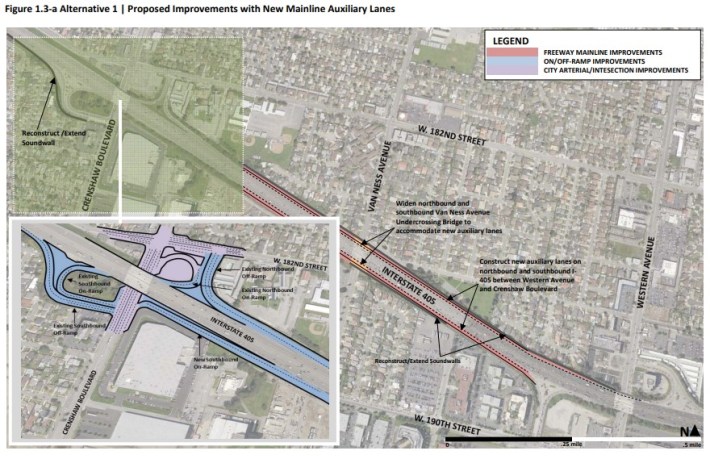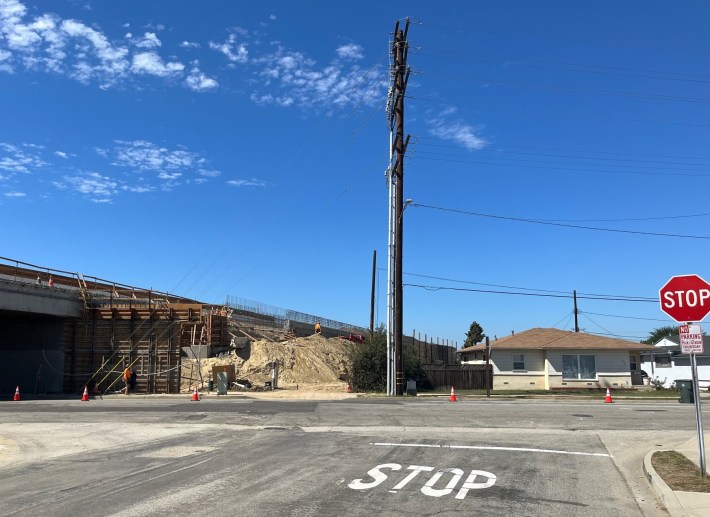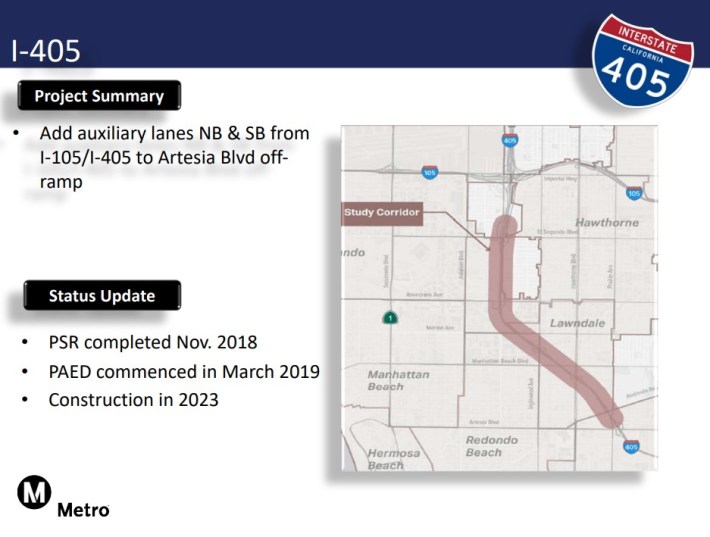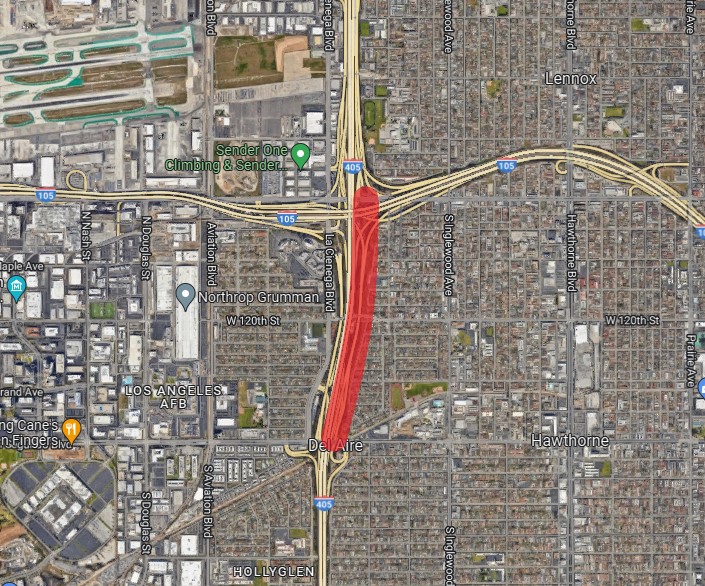In the next couple years, Metro and Caltrans plan to spend hundreds of millions of dollars widening the 405 Freeway through southwest and south L.A. County. Widening the 405 will result in more driving and more pollution in already pollution-burdened communities.
The agencies' current 405 Freeway expansion is broken up into at least four projects, detailed below.
Metro staff have asserted that these South Bay freeway widening projects (and many other freeway expansions) are not actually freeway widening. In Orwellian budget discussions earlier this year, Metro Senior Executive Officer Irene Fine termed these 405 Freeway widening projects as “local subregional projects” as opposed to “capacity improvement projects.” Part of Metro's problem is that, while touting equity and climate, the agency has a difficult time admitting that it is spending hundreds of millions of dollars every year widening freeways (and Metro's freeway spending is growing rapidly) - counter to those aims. Metro's enthusiastic freeway widening stance is, arguably, slowly changing, but the agency's budget shows it remains in denial of the climate emergency.
East to west, Metro's four current 405 Freeway expansion projects are:
- Add two new lanes between Wilmington Avenue and Main Street - in the city of Carson
- Add two new lanes between Western Avenue and Crenshaw Boulevard/182nd Street - in the city of Torrance
- Add two new lanes between Artesia Boulevard and the 105 Freeway - in the cities of Hawthorne, Lawndale, Redondo Beach and Torrance
- Add one new northbound lane from El Segundo Boulevard to Imperial Highway - in Hawthorne and unincorporated Del Aire
In addition to the four projects above, there are a few more 405 expansion projects in early stages, for which there is little to no project information available:
- Add new ExpressLanes from Orange County to the 10 Freeway
- Add new lanes between Main Street and Western Avenue - in Torrance, Carson, and unincorporated West Carson
- "Highway Operational Improvements" at the 405/110 separation - in Carson and West Carson (Metro funded this project at $17 million; no project details found.)
Also, in the same area, Metro and Caltrans have recently completed other recent 405 Freeway widening projects. In 2019, Metro, Caltrans, and the city of Carson completed their $27 million 405 Freeway Wilmington Avenue Interchange Modification, which added about 0.4-mile of westbound auxiliary lane and a new 0.3-mile on-ramp, and also widened Wilmington Avenue. To the north, there is also Metro and Caltrans' $1.6 billion widening of the 405 from the westside to the Valley (completed in 2016), which notoriously failed to deliver the congestion relief the agencies predicted.

Why all this widening? In addition to the longstanding federal and state (recently augmented by S.B. 1 gas tax money) pipelines for building more and wider freeways, the current batch of 405 Freeway widening projects have been made possible by Metro sales tax revenue. Measure R and Measure M both have pots of funding for "improvements" on the 405 Freeway through the South Bay. Measure R has $506 million for "ramp and interchange improvements" on the 405 and other South Bay freeways. Measure M has $150 million for "South Bay Curve Improvements" on the 405. Voters approved the Measure M 405 money to be scheduled for a 2045 groundbreaking, but (like other Metro freeway widenings, including the 57/60) Metro is looking to tap into Measure M funds sooner in order to accelerate construction.
Below, Streetsblog has some more detail on the four 405 widening projects listed above.
One thing that all the projects have in common is that they all add what are called "auxiliary lanes." These "aux lanes" generally run between one freeway on-ramp and the next off-ramp, so Caltrans engineers define them as "supplementary to through movement." Some pro-highway-expansion engineers tend to downplay auxiliary lanes, asserting that they are some kind of extra nice-to-have little shoulder (they are not shoulders - aux lanes have shoulders alongside them) and not really about increasing capacity.
Metro and Caltrans are planning and building lots of short - less than one mile long - auxiliary lane projects on several L.A. County freeways, including the 91, the 605, and the 405. Metro's 405 Freeway projects include at least sixteen segments where the agencies are widening the freeway by adding less than one mile of auxiliary lane. Why so many short aux lane segments? The reason appears to be because longer segments would require full environmental review.
When California reformed its CEQA (California Environmental Quality Act) standards in late 2018 - a change that largely shifted environmental studies from Level of Service (LOS) to Vehicle Miles Traveled (VMT) - it included a legal loophole for aux lane projects. The regulation states that induced driving does not need to be studied for "projects that would not likely lead to a substantial or measurable increase in vehicle travel," specifically including "addition of an auxiliary lane of less than one mile in length designed to improve roadway safety." While there are some questions regarding multiple auxiliary lanes in the same corridor having a cumulative effect, Metro and Caltrans District 7 have been busy approving numerous aux lane projects, generally under the least rigorous environmental study - typically a "categorical exemption" leading to a Finding of No Significant Impact (FONSI).
It is not clear if, by piecemealing larger projects, Metro is violating CEQA law, or is just exploiting an unfortunate legal loophole. The Texas Department of Transportation was recently sued for piecemealing too many large highway expansions into small FONSI segments.
Below is project detail for the four 405 widenings. Note that some of this information is incomplete, as Metro, Caltrans, and the South Bay Council of Governments (SBCOG) make very little information on these projects available online, and the agencies responded to Streetsblog's requests with minimal and incomplete information.

1. 405 from Wilmington Avenue to Main Street in Carson
Metro and Caltrans are planning to add five new auxiliary lane segments totaling about 4.5 new lane miles.
- Northbound from Wilmington Avenue on-ramp to Carson Street off-ramp: ~1.0 mile
- Northbound from Carson Street on-ramp to Avalon Boulevard off-ramp: ~0.7 mile
- Northbound from Weigh Station on-ramp to Main Street: ~1.0 mile
- Southbound from Avalon Boulevard on-ramp to Carson Street off-ramp: ~0.7 mile
- Southbound from Carson Street on-ramp to Wilmington Avenue off-ramp: ~1.0 mile
For the overall Carson project, Metro and Caltrans prepared a Project Study Report/Project Development Support (PSR) document, completed in 2022. The report anticipates construction cost will total $90-120 million.
Per chapter 8 of the PSR: "No permanent right of way acquisitions are anticipated in this project," as the project footprint is within existing Caltrans right of way.
Metro's 405 Wilmington-Main project page has exactly zero documents posted, but it still has more project information than Caltrans, SBCOG, and Carson websites. Upon request, Metro provided Streetsblog with the PSR document, but not its appendices, which include detail on the project's design and costs. When SBLA requested the report appendices, Metro spokesperson Patrick Chandler responded that "it appears that some of the information included in the appendices involves ROW [right of way] purchases, therefore Metro will likely not be able to provide that information at this time." Note that this statement contradicts the PSR, which states no ROW acquisitions are anticipated.
The Carson 405 widening project is scheduled to get the environmental clearance (Project Approval and Environmental Document - PAED) phase underway in Spring 2023, per Metro.

2. 405 from Western Avenue to Crenshaw Boulevard/182nd Street in Torrance
Metro, Caltrans, the South Bay Council of Governments, and the city of Torrance are widening the 405 Freeway at and near Crenshaw Boulevard. The $62 million project is currently under construction. It is adding nearly two miles of new auxiliary lanes:
- Northbound from Western Avenue on-ramp to Carson Street off-ramp: ~0.8 mile
- Southbound from 182nd Street to Crenshaw off-ramp: ~0.1 mile
- Southbound from Crenshaw on-ramp to Western/190th off-ramp: ~0.9 mile
In addition, this project is adding a quarter-mile-long new southbound on-ramp at Crenshaw, connecting the northbound on-ramp to Crenshaw, and widening a few blocks of Crenshaw Boulevard and 182nd Street.


This project's environmental studies, a FONSI, were approved in 2016. The FONSI asserts that this 405 Freeway widening will "promote improved regional air quality." It also claims that it will "relieve congestion by enhancing operations and improving travel times in high congestion travel corridors," and thus "GHG [greenhouse gas] emissions, particularly CO2, may be reduced."
According to the city of Torrance and Caltrans project pages, construction is anticipated to be completed in December 2023.
It is instructive to note that even widening a freeway in the higher-income city of Torrance has equity implications. Metro likes to suggest that these sorts of no-homes-demolished freeway projects have "truly equitable outcomes" (that's a quote from Metro's CEO describing North County 5 Freeway widening). Freeways, from the 105 to the 10 to the 110, and even the 405, have helped isolate, segregate, and erase Black communities. Metro, Caltrans, and Torrance should be aligning their spending toward remedying this history of injustice, not widening and hardening these divisions. Torrance, a whites-only sundown town into the 1960s where biased policing has long been a problem and remains so today, is (with Metro and Caltrans funding) widening its freeway to allow for more driving, more pollution, and more noise centered in its more diverse Northeast Torrance neighborhoods.

3. 405 from Artesia Boulevard to the 105 Freeway
Metro and Caltrans are planning to add seven new auxiliary lane segments totaling about ~5.5 new lane miles.
- Northbound from Redondo Beach Boulevard on-ramp to Hawthorne Boulevard off-ramp: ~0.7 mile
- Northbound from Hawthorne Boulevard on-ramp to Inglewood Avenue off-ramp: ~0.7 mile
- Northbound from Inglewood Avenue on-ramp to Rosecrans Avenue off-ramp: ~0.9 mile
- Southbound from the 105 Freeway connector through the El Segundo Boulevard on-/off-ramps to south of Rosecrans Avenue, and realign hook off-ramp: ~0.9 mile (This is not an auxiliary lane because it goes past the El Segundo Boulevard on/off-ramps.)
- Southbound from Rosecrans Avenue on-ramp to Inglewood Avenue off-ramp: ~0.9 mile
- Southbound from Inglewood Avenue on-ramp to Hawthorne Boulevard off-ramp: ~0.9 mile
- Southbound from Hawthorne Boulevard on-ramp to Redondo Beach Boulevard off-ramp: ~0.7 mile
For this widening, there is no detailed information on Metro (no Metro project page), Caltrans, or SBCOG websites. Metro completed a Project Study Report for this project in 2018. That PSR is not available online, and Metro communications staff declined to provide the report to SBLA.
The only project document available online is a twelve-page 2020 Notice of Exemption (NOE - similar to, but actually one step less rigorous than, a FONSI), which declares that adding these aux lanes is "categorically exempt" from further CEQA analysis.
In a 2020 Metro Highway Program presentation, the agency announced that construction was anticipated to start in 2023. Streetsblog inquired to Metro if this timeline was still accurate. Metro declined to respond to SBLA's question.
This project is currently funded for $17.4 million in the South Bay COG's approved Measure R Highway Program budget.
Updated 10/5: Responding to SBLA's CA Public Records Act request, today Metro released the Project Study Report (PSR) for this project, but declined to release the PSR appendices. Similar to the Main-Wilmington project above, Metro public records staff stated "We do not release the contents of real estate appraisals or engineering or feasibility estimates and evaluations made for or by Caltrans or Metro relative to the acquisition of property, or to prospective public supply and construction contracts until all of the property has been acquired or all of the contract agreements are obtained." This contradicts the PSR which notes that "it is not anticipated that permanent right of way acquisition will be required."
The PSR estimates that project construction will cost $100-120 million.
4. 405 from El Segundo Boulevard to Imperial Highway

Metro and Caltrans are planning to add just under one mile of 405 Freeway northbound auxiliary lane immediately south of the 105 Freeway. The project is described briefly in the Carson 405 widening PSR, and is currently funded for $14 million in the South Bay COG's approved Measure R Highway Program budget.







